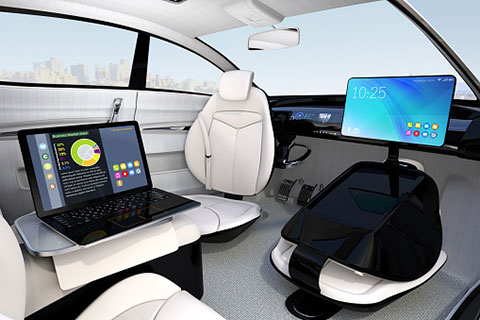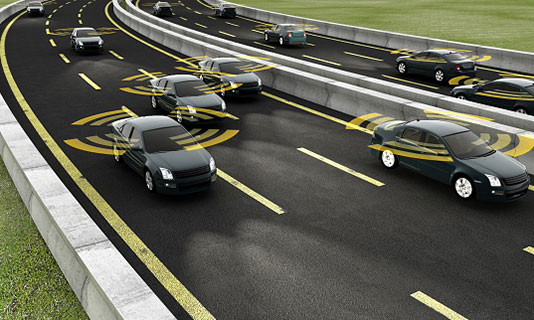What’s in a word? When it comes to the way the federal government looks at autonomous vehicles, more than you may think.
To help facilitate the robotic takeover of our driving skills, the National Highway Traffic Safety Administration (NHTSA) recently adopted a set of definitions meant to chart our cars’ evolution from something we drive to something driving us.
The language, which the auto industry has universally adopted, will undoubtedly help the federal agency dictate both the pace and policy by which the machines will evolve during this technological learning curve.
But it also has the power to arm consumers against the slick promises and sleight of hand often employed to provoke sales of an expensive item—a useful tool that could be applied at a time when many automakers are announcing their plans to release some sort of autonomous model within the next decade.
Next-Level Stuff
Developed in 2014 by the international Society of Automotive Engineers (SAE), the NHTSA officially adopted the terminology last year.
It describes the phases of a self-driving car with six levels, starting from 0 and ending at 5.
There are six levels of autonomous vehicles—starting at 0 with vehicles that may help you brake and ending at 5 with vehicles that lack steering wheels and pedals.
Interestingly, the design laid out by the SAE peaks with a model long championed by Google as the “ultimate” embodiment of an autonomous car.
The Internet giant’s embrace of that model, which does without steering wheels or gas and brake pedals, was a sore spot with the California Department of Motor Vehicles (DMV) for some time before the federal government officially OKed the prototype last year, leading to an uptick in its testing—including on California roads.
Still, there are several phases a car must go through first before it can reach that total realization of autonomy.
Level Zero
The first category should seem familiar—this level represents the type of cars humans have driven for more than 100 years: Ones that can’t do anything without our assistance.
Some new-age features, such as assisted warnings or automated emergency braking, can still be found on cars within this group, but acceleration, braking, and steering are otherwise human-controlled at all times. Essentially, it defines cars as we know them today.
Level One
When only one of the car’s major maneuvering apparatuses are computer-led, it’s considered Level One, called “driver assistance.” To be considered Level One, a car must be able to take control of either the steering or the pedals, but not both functions at once.
Off-road cruise control, such as the feature being offered by Jaguar on some Land Rover models, is considered a Level One quality, as well as the increasingly popular park assist.

Level Two
At this point, both pedals and steering can be taken over simultaneously, but only in certain situations. You may hear this described as “partial automation.”
Responsibility for controlling the vehicle ultimately still rests with the human driver.
The new Mercedes-Benz E Class as well as the autopilot system found in the Tesla S are both examples of this level.
Level Three
More than halfway there, this is when cars are officially considered “automated driving systems”—and the point at which humans are no longer primarily in charge of the car.
The machine will be capable of changing lanes and making other situational decisions, called “conditional automation,” although the person is still expected to pay attention, acting as a safeguard should the computer err in its judgment.
Many carmakers are hoping to leapfrog this tricky in-between stage as the question of liability, should an accident occur, is especially murky at this point.
Level Four
Now the real fun begins. Humans in a Level Four car don’t need to pay attention to what’s happening on the road at all—and in the future, probably won’t even need a driver’s license.
Called “high automation,” this is what most people likely imagine when they think of self-driving cars. The vehicle has full control of steering and the pedals and is capable of making dynamic decisions based on real-time traffic conditions.
Still, the auto includes a steering wheel, accelerator, and brake pads, so a human could drive the car if he or she wanted or needed to—such as if the vehicle encountered a tricky situation like an unpredictable construction zone.
When big automakers have announced their plans for self-driving cars, this is the level many have in mind, including Ford Motor Company, which has promised such models by 2021.
Level Five

The ultimate realization of self-driving cars, according to the Society of Automotive Engineers, these vehicles will be so adept at navigating our roads, they won’t include pedals or steering wheels.
While it may seem dangerous to humans used to having control of a car, Google has argued in the past that while testing Level Three or Four prototypes, its riders were actually a bigger risk factor than the cars themselves, becoming too distracted to handle any hand-off moment when they were expected to take over from the vehicle.
It’s also the reason why the future of auto design will likely focus more heavily on the vehicle’s interior and turning our cars’ “infotainment” centers into more traditional entertainment options.
On the Level
For long-time science fiction fans, the 21st century probably looks pretty familiar.
Numerous devices we use daily were first imagined decades or sometimes centuries ago by writers and storytellers who cast their minds far into the future of humankind and technology.
So it should come as no surprise to such readers that one of the most celebrated sci-fi authors in history was the muse for this new age taxonomy.
When releasing the terms, the SAE cited Isaac Asimov as inspiration. Specifically, they said they took a cue from the author’s “Three Laws of Robotics,” a short list of commandments that must be adhered to by all artificial life in his stories, including in his famous novel I, Robot.
Paramount among those laws is this: “A robot may not injure a human being or, through inaction, allow a human being to come to harm.”
While there may be certain cases where this rule is impossible for self-driving cars to follow, if Level Five autonomy truly is the fate of our vehicles, all we can do is hope that the laws of the road are not the only ones they’re taught.
